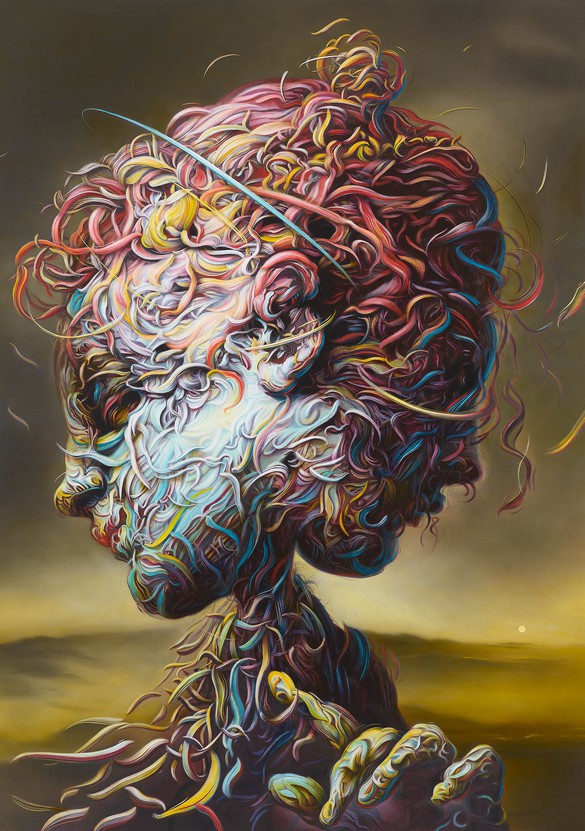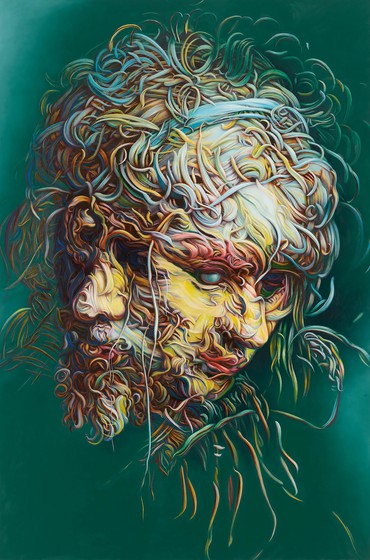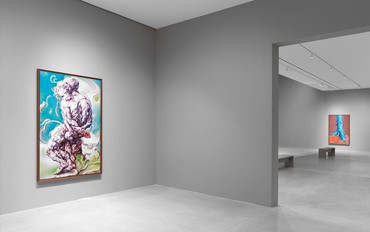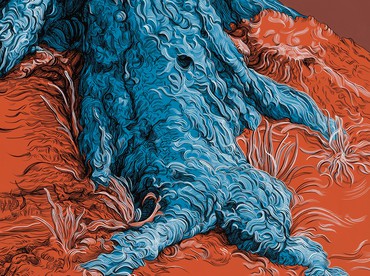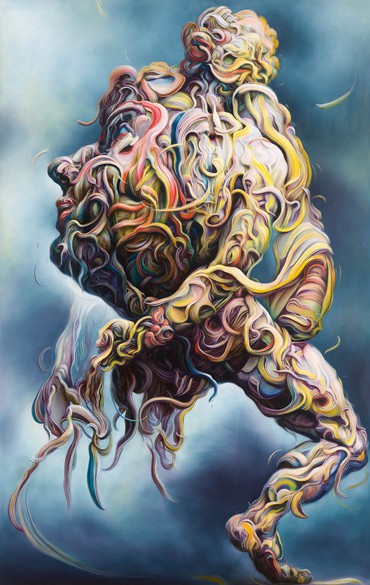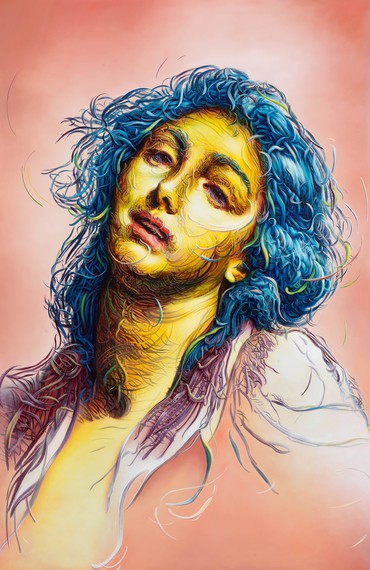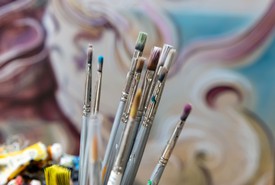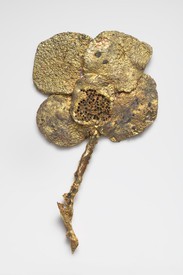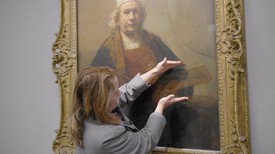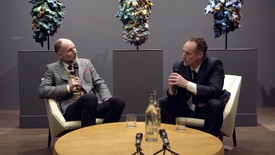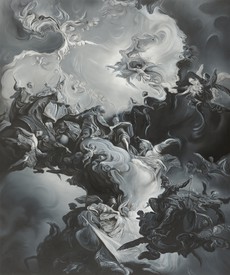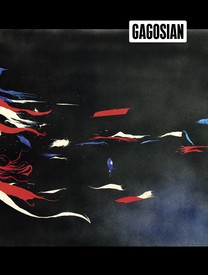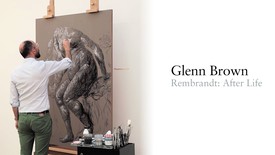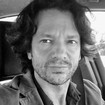
Andrew Winer is the author of the novels The Marriage Artist (2010) and The Color Midnight Made (2002). He writes and lectures on art, philosophy, and literature. A recipient of a National Endowment for the Arts Fellowship in fiction, he is presently completing a novel and a book on the contemporary relevance of Friedrich Nietzsche’s central philosophical idea, the affirmation of life.
It’s late, Glenn Brown’s opening is over, and at last all sixty of our party—dealers, collectors, curators, gallery staff, friends, and various beautiful people—have snuggled into the tables that have been reserved at a hip new restaurant in Chelsea. To our relief, waters arrive, followed by wine and hors d’oeuvres—extraordinary Tuscan things we can’t wait to try—but then the artist gets to his feet with a curl of paper in his hand. He’s making a speech.
“The Over-Soul,” Brown explains, referring to the Emersonian concept that inspired one of his paintings, “concerns whether we have a soul or not.”
Everyone at my table reaches for their wineglass.
Any artist willing to regale a restaurant full of hungry art-world cognoscenti with a lesson on Ralph Waldo Emerson is after my own heart. But that will not be the only lesson. Standing there in his elegant three-piece suit as waiters push past, Brown shares that he was given the middle name “Emerson” by his late father, who had derived his sense of morality from the great American transcendentalist. It’s his father’s tie that Brown is wearing tonight, an homage to how much the man helped him with his paintings. Help that was apparently needed. “I’m fifty-six,” he continues, “and it feels like painting is this most awful mistress that you try and please, but she just punishes you. You keep struggling and fighting with it, you want this marriage to work. But we never actually get to make the painting we actually really set out to make. And my father used to look at the painting I was working on and tell me, ‘Within painting you cannot lie. You think you’ve gotten away with it, Glenn. But like Emerson tells us, honesty and integrity are the most important parts of being an artist.’”
What has Brown gotten away with?
“I’m pointedly lying. My paintings are completely dishonest.” I’m walking with him through the gallery the following morning and we’ve arrived at the painting that lent the show its title, We’ll Keep On Dancing Till We Pay the Rent, because he wants me to examine the color-drenched, two-faced head that graphically dominates the canvas, a sort of iconic modern-day Janus. “Look—it’s not real painting. It’s pretend painting. Pretend white light that comes from the left here, fake red light emanating from the right, yellow light coming down from there—I have imaginary lights lighting every single brushstroke, leaving some of them in shadow and some in light.” He points to one of the many large, overlapping, whipping brushstrokes that, in aggregate, seem to thickly make up the head (some of them are also twirling and peeling and otherwise falling away from it). “There are umpteen lines there in any single brushstroke. I’m trying to trick the eye. Make the stroke look three-dimensional. But it’s all smooth.” Indeed, the strokes’ impasto look is simulated. What appears to be spontaneous, heavily applied brushwork is the result of a laborious, precise, lapidary process—and all of it is pressed beneath the glassy surface of the painting. “For many artists—look at Joan Mitchell—their work sits on the picture plane. Or Willem de Kooning. Frank Auerbach. My work exists on the other side of the picture plane. It’s illusion and the use of trompe l’oeil and perspective, which is not a modernist thing to do, generally. It’s artifice. It doesn’t tell you the truth of how it’s made.”
Nearly all good paintings enjoin us to contemplate how they were made. Brown’s do so swiftly and arrestingly. He’s a superb draftsman and an equally superb image-maker, and his show’s large heads and figures seem to punch out into the gallery with graphic, eye-catching boldness. Yet they don’t catch your eye with their eyes. By intention, none meets your gaze. “It’s rude to stare,” Brown tells me. “But these will never stare back at you, so it gives you permission to look.” What else is there to do but look, then—how is each painting made? For Brown, the answer is brushstrokes, brushstrokes, brushstrokes. But it isn’t simple.
In a way, every painter has to search for permission to paint. Something else Brown has gotten away with: making paintings at all. That may seem a funny thing to say, but the charge to self-justify is embedded in modern art’s subservience to the avant-gardist idea that it must constantly evolve, rejecting what came before (even as it indirectly furthers, sometimes, what has been). In the 1950s, the Abstract Expressionists fervently adopted this history-erasing ethos, which evolved into Pop indifference before being turned into something like dogma by Conceptualism and Minimalism. By the time Brown was an art student, several schools of artists had emerged with another attitude toward progress in art: the Pictures Generation, the Neo-Expressionists, the appropriation artists, and the Neo-Geo painters retained the idea that art must evolve, but they were interested in finding ways to work with art history—an interest that you might say was forced on them by an abiding sense that art had reached a point of exhaustion. What about it was exhausted, exactly? Certainly the idea of authenticity and originality, the privileged status of a work of art. The image as a carrier of meaning and significance came into question. And in the case of painting, a related, older sort of exhaustion inhered: namely, a distrust—felt by Jasper Johns and Robert Rauschenberg as early as the mid-1950s—of the expressive mark’s ability to convey meaning.
Yet the history of art has proven that exhaustion can lead to renewal and freedom. And the reduced status of the image, the brushstroke, and the work of art itself paradoxically made each of these not only serviceable but enticing as raw material to artists of the 1970s and ’80s, who were inclined to use them with a new knowingness. Driven by a sense of intellectual authority inherited from Conceptualism, such artists as David Salle, Sherrie Levine, and a whole host of their contemporaries claimed a new freedom to fish out and use images from a grab bag history of art and culture. Then there were those oriented around the brushstroke. For the most part eschewing any conceptual justification, painters such as Georg Baselitz, Julian Schnabel, and Jean-Michel Basquiat wielded the expressive mark anew, often with a sort of devil-may-care abandon. Whatever justification they sought or claimed for all the demonstrative painterly license they were taking showed up as some mix of irony, self-consciousness, or cultural signification. A cooler approach was adopted by painters like Brice Marden and, in his abstract canvases, Gerhard Richter, who found various mediated means to produce strokes that were pleasing but drained of much of the emotiveness that attended the work of their Neo-Expressionist contemporaries. (Anselm Kiefer can be thought of as an amalgam of these hot and cool approaches: his brushwork is manifestly loose and expressive, yet fettered by the grim task of grappling with some ugly German history.) Such were the currents into which the young Glenn Brown and his contemporaries first dipped their toes. But as roiling and vigorous as those postmodern seas were, even they, for Brown’s generation, gave off a slightly malodorous reek of exhaustion.
It so happens that I’m Brown’s exact age, having matured in the late ’80s—after the party was over. But then the party was over for our generation before we ever knew what the art world was: if our parents in the ’60s and ’70s experienced the vertiginous feeling of living in a way no one seemed to have before, we experienced living in a hundred different ways that had just been lived. (I am suddenly reminded by this, and by Brown’s paintings, of waking up as a child to a house strewn with sleeping hippies, wine bottles, smelly old food, dirty plates, half-smoked doobies, gothic-looking album covers, sci-fi novels, books on ecology and philosophy and cabin building, and a pot of spiced wine on the stove, still warm and fragrant, beneath a framed, counterfeit Salvador Dalí etching.) What were we to do, in our youth, but cherry-pick from the leftovers? Later, in the arena of cultural production occupied by artists (always more advanced than parents!), we had no choice but to cherry-pick from the leftovers of the leftovers. For painters, this often meant leaping backward over the postmodernists and over the history-annihilating Minimalists and Pop artists—sometimes to the Abstract Expressionists (as in the case of Cecily Brown) or even much farther back (as in the case of John Currin). Brown leapt, and continues to leap, back to all such places, taking his imagery mainly from the old masters and his technique from Abstract Expressionism—with a twist.
That twist, an inward one, emerged from the fact that Brown, like other art students of his generation, took his justification less from Conceptualism than from French and German theorists. The influence of semiotics, poststructuralism, and deconstruction encouraged these fledgling artists to look not just at the language of a made thing but at the smallest components of that language. Brown, arguably, looked harder in this direction than most of his generation did, and it’s part of what led him, oddly enough, toward that old exhausted thing: the expressive brushstroke. But his love for the work of de Kooning and Rauschenberg in America, and of Auerbach, Lucian Freud, and Francis Bacon in his own country, also led him to the brushstroke—even if that love can’t quite be separated, in my opinion, from Brown’s mischievous desire to go toward what is least fashionable.
What to do, though, with the brushstroke?
Rauschenberg, having gone about deconstructing and reconstructing Abstract Expressionism in the 1950s with a kind of insouciance, offered a clue. Brown certainly seemed to want to pay expressionism, among his other historical references, the compliment of repurposing and reconstruction—of homage rather than outright rejection. But so did the Neo-Expressionists in the ’80s; how was Brown to distinguish what he was doing from their efforts? Another, less obvious clue came from farther back, in one of those unfashionable precincts where dwelled artists such as Fragonard. “I’ve always been trying to save him from the guillotine,” Brown admits when I ask what the Rococo painter has meant to him, “because taste is continually trying to string him up. But take his suite of paintings in the Frick: the subject matter is really rather downplayed, and if you look at them as abstract paintings, you get a sense that this is all a dream because of the way everything is painted. His gelatinous mark-making causes you to think that everything is made of the same material almost.” How could Brown deconstruct expressionism and realism at the same time? How could he make a kind of realist painting that feels as artificial as an Abstract Expressionist painting—that “makes you think that everything is made of the same material”? Brown’s solution, following the model of the poststructuralism he was reading, was to take his deconstructing down to the smallest possible unit of the language of painting. If artists throughout history had acknowledged the artificiality of painting in a thousand different ways, it was time to take the artificiality inside the stroke.
Brown must have galled more than one envious peer trying to figure out, as many were then, how to get away with de Kooning– or Auerbach-like brushwork without copying Richter. He had found a way to pay his own kind of homage. As with Richter, it was ironic homage, to be sure, but not cheapened. (Accusations of cleverness and trickery will ring hollow to anyone who really looks at what Brown achieves with his trompe l’oeil brushstrokes: they’re simply too adept, too bravura, too fun, not to be taken seriously.) To be successful, homage of this sort must first be directed just to the right or left of the thing to which homage is primarily being paid. Richter’s abstract paintings pay homage to photography, for example, on their way to paying respect to expressionism. So what about Brown? His paintings ultimately pay homage to expressionism as well, but before that, they defer to something that no longer exists, something that was lost when we “wised up” about painting in the ’60s and ’70s. I’m not referring to the mid-twentieth-century idea, questionable even then, of painting as an activity that, for the artist, is self-actualizing, self-fashioning, and self-expressive. I’m referring to that idea’s more defensible concomitant: that the extemporized brushstroke is a vessel or catalyst for feeling.
Still, Brown’s brushstrokes ought to make us feel. Is there not something poignant about his dedicating years of very fine painting to an idea that was for him and his contemporaries already debunked? And what about the haunting fact that he reproduces brushstrokes that never were? Or that he can spend many hours on a stroke that might have taken an expressionist a second? A lot of longing attaches to this enterprise. I’m deeply moved by it; I hope other viewers are too. Brown’s strokes may be slowly crafted simulations that exert a subtle steeliness across the canvas, but such is our contemporary fate: that feeling, like the humans who carry it, must come through metal detectors in order to fly.
What is life? What are we doing here? Brown’s paintings, for all their incendiary, campy colors, for all their denial of art’s old heroism, still ask these philosophical, even spiritual questions. They, along with the three drawings in the show into which Brown also layered multiple images, have something to say about the complexity of being a person. And this is the final thing that Brown gets away with: being a storyteller. (Even though narrative painting made a comeback forty years ago after its banishment by abstraction and Minimalism, and despite having always had an audience, it continues to sit uneasily with more than a few critics and theorists, and indeed with a number of artists.) So what story is Brown telling? “I’m not trying to depict the world as it is,” he tells me as we stand before The Holy Bible, his sensational painting of a tree trunk that has the flatness of Pop and the somber blues and browns of Dutch landscape. I take in the tree’s burled bark and knobby, almost grotesque roots. “I’m trying to describe the world as it might be if it could express itself,” Brown goes on. “So hence the tree starts to describe what it might be to be a tree. And the human body tries to describe all the pains and agonies, the loves and sexual drive that’s within our bodies. And not just that: I’m trying to describe the world as it might be if we stopped dominating it. So this tree is a fully sentient being—literally has faces in it. When I paint trees, I paint them as if they are people. And I paint people as if they are trees. Everything becomes more exuberant. It’s very much against the classical idea of the perfect human.”
Brown is certainly telling that story, too—of the imperfect human. This is a good thing, though not because we will find reassurance there. Selfhood in our altered world is an anxious place, as this show makes obvious. In the final room of the gallery, we at last face The Over-Soul, in which an enormous female face merges with a smaller male figure against an indeterminate blue-and-white background. “I’d like my paintings to describe not what the human body looks like, but what the human body feels like,” Brown declares, echoing the Mannerist credo about distorting the parts of the body that are more important. “If you close your eyes and imagine what your body is, then that’s what I’m trying to depict here. So it’s the human body from the inside out. Your stomach, your intestines, your musculature, your bones—they’re just as important as what happens to be on the outside.” Brown puts Surrealism at the service not of the unconscious, then, but of the body—at the service of a self that is multiple, androgynous, contingent. . . .
And psychologically cocooned. By preventing his figures’ eyes from meeting ours, Brown delivers portraits of subjective solitude caught in a moment (not in an instant: there’s too much movement, and anyway instants are the same thing as forever, where all portraits of people meeting our eyes live). In this sense Brown is a realist. Catch anyone in a moment and what you will get is the reality of their aloneness. Togetherness, like happiness, is banked on the fiction of the always incipient next moment: the thing that will be said, the love that will be expressed, the meeting that will occur, the physical contact that will be made. Take the next moment away for a moment, and, as at the moment of death, we are irremediably alone in the universe. Brown’s snaking, intertwining brushstrokes, fastened together by nothing more than the artist’s precise and subtle wrist action, seem to embody and enact, in this way, the reckoning mind: synapses grappling with absolute questions, always at risk of fragmenting into chaos. Here, Brown’s paintings prove that art can still do its old job of revelation, or, at a minimum, of offering apt metaphors for our tenuous present-day condition. To look at them is to see that truth, beauty, and other values that make life worth living turn out to be human made. It’s to see that our ultimate concerns, resistant to earnest representation, are constructed things, requiring the most advanced tools of leavening and artifice—irony, deflection, dissonance, and wit—to make a rare appearance. But Brown’s paradox extends even further: heartbreakingly, these figures are only representations—representations of other representations. They live nowhere but in paint. We have to look at dead things to know how to live. Brown is a realist because he catches us in the problem of being at all.
Not bad for a self-declared Marxist who, performerlike, accepts democracy’s leveling effects when it comes to his audience. His tastes may run to the more embarrassing jewels of art history, but once he has drawn his subjects on the canvas, they stop mattering, becoming for him little more than overlapping congeries of lines. Then he begins to paint, turning up the heat with imitations of slashing strokes and the acidic colors of our time, weaning old master charm and splendor into proper plebeian shape. Only the drawings, with the help of almost comically ornate frames, are easily traceable to the old masters. For this reason I give them pride of place in my imaginary lobby installation of Glenn Browns at museums of old paintings the world over. If people could only be made to walk through a room of Browns before entering those venerable institutions, their hearts might be alleviated of fears of elitism, their eyes might be opened to what still matters in the old masterworks. In this sense Brown’s work is like a bridge left standing amid the devastation wreaked on high art and subtle sensibilities by war and entertainment and grim commercial prudence, to say nothing of populist resentment and radical egalitarianism. “I think it’s that balance between beauty and the bourgeois and the sort of underbelly and turgid shit,” Brown tells me as we pause before one last painting—of a ravishing woman’s face—that he has entitled Led Zeppelin II. “I was talking to John Currin with the couple who bought this and he said, ‘What’s that color you’re using on her face? It sort of looks like warm piss.’ I told him it is piss! It’s painted with Indian yellow, which is made with the urine of oxen that they’ve fed with mango leaves. So I’m asking for somebody to look at these as both beautiful, like a sort of delicatessen, and rather stinking and shitlike.”
I mention Milan Kundera’s notion, in his novel The Unbearable Lightness of Being (1984), that kitsch is the fear of shit.
Brown looks surprised. “What does that mean?”
“Well,” I say, “that the saccharine clichés of kitsch represent a kind of running away from shit. A pretending that we don’t have plumbing pipes to take away our fecal waste.”
His eyes do a tour of his paintings around the gallery, and then he looks at me almost apologetically. “I mean—” he starts, and stops. Then, in a confiding tone: “All of the paintings here do look to me very kitsch.”
He catches me staring at the piss-yellow face in front of us.
“Like I say, my paintings are completely inauthentic,” he offers. “Any emotion you see in them isn’t necessarily emotion I feel.”
“But do you like to paint?” I ask.
“I like it more than anything else.” He chuckles, before turning serious. “Really—anything else.”
There’s a pause. We’re both winding down, tired from the late dinner last night and from a long, fruitful conversation today.
“People think you have so much talent,” he says with a faint tinge of regret. “They’re trying to read my work. It’s still the thing of the genius artist. Which I just don’t believe. I wasn’t born with any more talent than anybody else. I just learnt to do it.”
“So it’s a performance?”
“Life is a performance.”
“Was the speech you made at the restaurant a performance?”
He breaks into a smile. “You have to stand up and sing for your supper. Quite literally, in that case. It’s part of the role of being an artist. There’s the cliché of the isolated existentialist outsider artist. For about fifteen or sixteen years I sort of played that game, because I never allowed myself to be photographed. Then it just became impossible, because people would just come up and shoot me with their phones.”
“Was it because you wanted anonymity?”
He nods. “Because I didn’t want people to know who made the paintings. Because they’re not real gestures. They exist in this other world. And I wanted me to exist in this other world too, in people’s minds.”
“But maybe it was also an effort,” I suggest, “to be a little mysterious.”
A bashful look comes into his face. “It seemed like a good idea.”
“Nevertheless you came to your openings, I assume—you made appearances.”
“Mostly. Sometimes I actually didn’t turn up.” He gives me a nervous glance before averting his gaze. “I mean—I’d tell everybody. I’m polite.”
His almost dandyish contradiction is extremely winning. Still, after all his talk of insincerity, inauthenticity, and performance, I find myself reminding him of his emotional speech about his father and Emerson at the dinner: how honesty and integrity is the most important part of being an artist.
Now our eyes meet, for a moment.
“One of the last paintings he saw me make was Dirty Creamer,” he tells me, referring to the first painting you see upon entering the show. It portrays the comical character of a hearty bagpiper, he explains, based on a Flemish Baroque drawing known to represent the Dutch proverb that the young always follow the example of the old. I sense a bit of sentiment suddenly rising in Brown. “He really didn’t like that painting,” he continues, and we both laugh. “‘Why would anyone want that painting on the wall?’ my father said. ‘He looks like such an unpleasant and untrustworthy guy. You feel like you’d need to check your pockets when he walked into the room.’”
“Nice,” I offer.
And as if to correct me, he says of his not-so-nice bagpiper, “I don’t want you to like him. I just wanted you to think that, somewhere in his soul, was a little element of goodness that might make him interesting.”
Glenn Brown: We’ll Keep On Dancing Till We Pay the Rent, Gagosian, 541 West 24th Street, New York, November 8–December 23, 2022
Artwork © Glenn Brown
